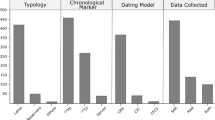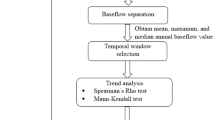Abstract
Understanding the patterns of marsh growth hasprimarily been based on modeling. Empiricalverifications of such models are difficult. This isattributed to the inability of available techniques togenerate past annual accretion rates from marshsediment cores and the need for an extremely longobservation period if a set of present day accretionrates is to be collected and used for such a purpose.Hypothetically, the large variation in temperaturebetween summer and winter, occurring on some saltmarshes, affects the viscosity of the tidal watersinundating and consequently the characteristics of thesediments deposited on the marsh surface. Thevariability of characteristics between seasonallydeposited sediment can be used as annual markers toderive annual accretion rates. Sedimentationexperiments at various temperatures and detailedanalyses of core sediments, cut at 1 mm. intervals,from two selected Humber marshes, were conducted totest the hypothesis.The sedimentation experiments showed that sedimentskewness, a sedimentological characteristic used toindicate the symmetry of the sediment distributioncurve about the mean, is most sensitive to variationsin water temperature and can be used as annual markersin marsh sediments. Detailed sedimentological analysesof two Humber marsh cores showed skew variabilityfollows a low magnitude cyclicity throughout bothcores. Using a 3 year time lag period and thenegative skew peaks as annual markers, correlationbetween a set of peak negative skew values, occurringwithin a dated section of the core, and the averagesummer field temperatures was found to bestatistically significant. The period for sediment toaccumulate within the dated section was calculated toequal the period derived from the dateable pollutanthorizons respectively. Additionally, the annualaccretion rates derived using the negative skew peaksas annual markers are comparable to the observedaverage annual accretion rates previously reported.
Similar content being viewed by others
References
Allen, J.R.L. 1990a. Constraints on measurement of sea level movements from salt marsh accretion rates. Journal of the Geological Society, London 147: 5-7.
Allen, J.R.L. 1990b. The formation of coastal peat marshes under an upward tendency of relative sea level. Journal of the Geological Society, London 147: 743-745.
Allen, J.R.L. 1990c. Salt marsh growth and stratification: A numerical model with special reference to the Severn Estuary, Southwest Britain. Marine Geology 75 (2): 77-96.
Allen, J.R.L. and Rae, J.E. 1988. Vertical salt marsh accretion since the Roman period in the Severn estuary, Southwest Britain. Marine Geology 83: 225-235.
Anderson, F.E. 1983. The Northern muddy Intertidal: Seasonal factors controlling erosion and deposition — A review. Canadian Journal of Fisheries and Aquatic Science 40 (1): 143-159.
Anderson, F.E. and Mayer, M.M. 1984. Seasonal and spatial variability of particulate matter of a muddy intertidal flood front. Sedimentology 31: 383-394.
Armentano, T.V. and Woodell, G.M. 1975. Sedimentation rates in a Long Island marsh determined by Pb-210 dating. Limnology and Oceanography 20: 452-456.
Bloom, A.L. 1964. Peat accumulation and compaction in a Connecticut coastal marsh. Journal of Sedimentary Petrology 34(3): 599-603.
Bloom, A.L. and Stuiver, M. 1963. Submergence of the Connecticut coast. Science 139: 332-334.
Buller, A.T. and McManus, J. 1979. Sediment sampling and analysis. In: Dyer, K.R. (ed.), Estuarine Hydrography and Sedimentation. Cambridge University Press, London.
Ciavolla, P. and Covelli, S. 1994. Coastal-estuary flux of heavy metals: The us of estuarine saltmarshes as a recorder of pollution in the Humber estuary, U.K. pp. 232-245. Proceedings of LITTORAL '94. Lisbon Portugal.
Clark, J.S. and Patterson, W.A. III. 1985. The development of a tidal marsh: Upland and oceanic influences. Ecological Monograph 55: 189-217.
DeLaune, R.D., Patrick, W.H. and Buresh, R.J. 1978. Sedimentation rates determined by Cs-137 dating in a rapidly accreting salt marsh. Nature 275: 532-533.
DeLaune, R.D., Smith, C.J. and Patrick, W.H. 1986. Sedimentation patterns in a Gulf Coast backbarrier marsh: Response to increasing submergence. Earth Surface Processes and Landforms 11: 485-490.
Dyer, K.R. 1986. Coastal and estuarine sediment dynamics. Wiley Interscience, Chichester.
Edwards, J.M. and Frey, R.W. 1977. Substrate characteristics within a Holocene salt marsh, Sapelo Island, Georgia. Seckenberg Maritime 9: 215-259.
Frey, R.W. and Basan, P.B. 1985. Coastal salt marshes. In: Davis, R.A. (ed.), Coastal Sedimentary Environments. Springer-Verlag, New York.
Gardner, L.R., Thombs, L., Edwards, D. and Nelson, D. 1989. Time series analyses of suspended sediment concentrations at North Inlet, South Carolina. Estuaries 12(4): 211-221.
Goldberg, E.D., Griffin, J.J., Hodge, V. and Koide, M. 1979. Pollution History of the Savannah river estuary. Environment Science and Technology 13: 588-594.
Grant, A. and Middleton, R. 1990. An Assessment of metal contamination of sediments in the Humber estuary, U.K. Estuarine Coastal and Shelf Science 31: 71-85.
Griffiths, J.C. 1967. Scientific methods in analysis of sediments. cGraw Hill, New York.
Hatton, R.S., Delaune, R.D. and Patrick, W.H. Jr. 1983. Sedimentation, accretion, and subsidence in marshes of Barataria Basin, Louisiana. Limnology and Oceanography 28(3): 494-502.
Hawkins, A.B., Larnach, W.J., Lloyd, I.M. and Nash, D.F.T. 1989. Selecting the location, and the initial investigation of the SERC soft clay test bed site. Quarterly Journal of Engineering Geology 22: 281-316.
Heltzel, S.B. and Teeter, A.M. 1987. Settling of Cohesive sediments. In: Kraus, N.C. (ed.), Coastal Sediments '87. American Society of Civil Engineers, New York.
Hoffman, J.S. 1984. Estimates of future sea level rise. In: Barth, M.C. and Titus, J.G. (eds.), Greenhouse Effect and Sea Level Rise. A Challenge for this Generation. Van Nostrand Reinhold, New York.
Hoffman, J.S., Keyes, D. and Titus, J.G. 1983. Projecting future sea level rise. EPA. U.S. Government Printing Office, Washington D.C.
House of Lords. 1984. Waste from the Titanium Dioxide industry. House of Lords select committee on the European communities, session 1983–84, 13th Report London, HMSO.
Husain, M.L. 1991. Salt Marsh Sedimentary Response to Sea Level Rise. Ph.D. Thesis. University of Hull.
Koldijk, W.S. 1968. On environment sensitive grain size parameters. Sedimentology 10: 57-69.
Middleton, R. and Grant, A. 1990. Heavy metals in the Humber estuary: Scrobicularia clay as a pre-industrial datum. Yorkshire Geological Society 48(1): 75-80.
Mudie, P.J. and Byrne, R. 1980. Pollen Evidence for Historic sedimentation Rates in California Coastal Marshes. Estuarine Coastal and Marine Science 10: 305-316.
Pethick, J.S. 1981. Long term accretion rates on tidal salt marshes. Journal of Sedimentary Petrology 51(2): 571-577.
Pethick, J.S. 1990. The Humber estuary. In: Ellis, S. and Crowther, D.R. (eds.), Humber Perspectives: A Region through the Ages. pp. 54-70. Hull University Press, Hull.
Pethick, J.S. and Barton, M. 1987. Accretion erosion sequences on Humber salt marshes, Estuarine and Brackishwaters Assosciation Bulletin 48: 29-30.
Postma, H. 1967. Sediment transport and sedimentation in the estuarine environment. In: Lauff, G.H. (ed.), Estauries, Publication No. 83. pp. 158-179. Washington, D.C., American Association for The Advancemant of Science.
Ranwell, D.S. 1964. Spartina salt marshes in southern England: II. Rate and seasonal pattern of sediment accretion. Journal of Ecology 52: 79-94.
Redfield, A.C. 1972. Development of a new England salt marsh. Ecological Monographs 42: 201-237.
Revelle, R. 1983. Probable future changes in sea level from increased atmospheric carbon dioxide. In: Changing climate, Carbon dioxide assessment committee. Washington D.C. National Academy Press (eds).
Roberts, H. 1990. X-Radiography. In: Goudie, A. (ed.), Geomorphological Techniques. pp. 141-142. Unwin Hyman, London.
Robinson, D.N. 1970. Coastal evolution in north-east Lincolnshire. The East Midland Geographer. 5(1&2): 62-70.
Sahu, A.K. 1990. A study of heavy metal dustribution in the Humber estuary with special reference to Arsenic and its effects on Hediste (Nereis) Diversicolor (O.F. Muller). Ph.D. Thesis. University of Hull.
Sinex, S.A. and Helz, H.R. 1981. Regional geochemistry of trace elements in Cheasapeake Bay sediments. Environmental Geochemistry 3(6): 315-323.
Sinex, S.A. and Wright, W.A. 1988. Distribution of trace metals in the sediments and biota of Cheasapeake Bay. Marine Pollution Bulletin 19(9): 425-431.
Steers, J.A. 1977. Physiography. In: Chapman, V.J. (ed.), Wet Coastal Ecosystem. pp. 31-60. Amsterdam, Elsevier.
Stevenson, J.C., Ward, L.G. and Kearney, M.S. 1986. Vertical accretion in marshes with varying rates of sea level rise. In: Wolfe, D.A. (ed.), Estuarine Variability. Academic Press, New York.
Stoddart, D.R., Reed, D.J. and French, J.R. 1989. Understanding salt marsh accretion, Scolt Head island, Norfolk, England. Estuaries 12(4): 228-236.
Weller, J.M. 1959. Compaction of sediments. American Association of Petroleum Geologist Bulletin 43: 273-310.
Author information
Authors and Affiliations
Rights and permissions
About this article
Cite this article
Mohd-Lokman, H., Pethick, J. Seasonality of sediment skewness as a geochronological tool for the Humber salt marshes, U.K.. Wetlands Ecology and Management 9, 1–12 (2001). https://doi.org/10.1023/A:1008403707961
Issue Date:
DOI: https://doi.org/10.1023/A:1008403707961




